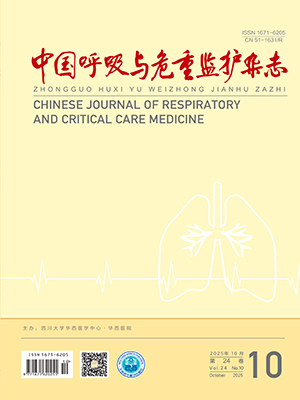| 1. |
Weingart SD, Levitan RM. Preoxygenation and prevention of desaturation during emergency airway management. Ann Emerg Med, 2012, 59(3): 165-175.
|
| 2. |
Jaber S, Amraoui J, Lefrant JY, et al. Clinical practice and risk factors for immediate complications of endotracheal intubation in the intensive care unit: a prospective, multiple-center study. Crit Care Med, 2006, 34(9): 2355-2361.
|
| 3. |
Griesdale DE, Bosma TL, Kurth T, et al. Complications of endotracheal intubation in the critically ill. Intensive Care Med, 2008, 34(10): 1835-1842.
|
| 4. |
Simon M, Wachs C, Braune S, et al. High-flow nasal cannula versus bag-valve-mask for preoxygenation before intubation in subjects with hypoxemic respiratory failure. Respir Care, 2016, 61(9): 1160-1167.
|
| 5. |
Groombridge C, Chin CW, Hanrahan B, et al. Assessment of common preoxygenation strategies outside of the operating room environment. Acad Emerg Med, 2016, 23(3): 342-346.
|
| 6. |
Baraka AS, Taha SK, Aouad MT, et al. Preoxygenation: comparison of maximal breathing and tidal volume breathing techniques. Anesthesiology, 1999, 91(3): 612-616.
|
| 7. |
Benumof JL. Preoxygenation: best method for both efficacy and efficiency. Anesthesiology, 1999, 91(3): 603-605.
|
| 8. |
Mort TC. Preoxygenation in critically ill patients requiring emergency tracheal intubation. Crit Care Med, 2005, 33(11): 2672-2675.
|
| 9. |
Reynolds SF, Heffner J. Airway management of the critically ill patient: rapid-sequence intubation. Chest, 2005, 127(4): 1397-1412.
|
| 10. |
Schwartz DE, Matthay MA, Cohen NH. Death and other complications of emergency airway management in critically ill adults. A prospective investigation of 297 tracheal intubations. Anesthesiology, 1995, 82(2): 367-376.
|
| 11. |
Farmery AD, Roe PG. A model to describe the rate of oxyhaemoglobin desaturation during apnoea. Br J Anaesth, 1996, 76(2): 284-291.
|
| 12. |
Miguel-Montanes R, Hajage D, Messika J, et al. Use of high-flow nasal cannula oxygen therapy to prevent desaturation during tracheal intubation of intensive care patients with mild-to-moderate hypoxemia. Crit Care Med, 2015, 43(3): 574-583.
|
| 13. |
Vourc'h M, Asfar P, Volteau C, et al. High-flow nasal cannula oxygen during endotracheal intubation in hypoxemic patients: a randomized controlled clinical trial. Intensive Care Med, 2015, 41(9): 1538-1548.
|
| 14. |
Jaber S, Monnin M, Girard M, et al. Apnoeic oxygenation via high-flow nasal cannula oxygen combined with non-invasive ventilation preoxygenation for intubation in hypoxaemic patients in the intensive care unit: the single-centre, blinded, randomised controlled OPTINIV trial. Intensive Care Med, 2016, 42(12): 1877-1887.
|
| 15. |
Gregoretti C, Pisani L, Cortegiani A, et al. Noninvasive ventilation in critically ill patients. Crit Care Clin, 2015, 31(3): 435-457.
|
| 16. |
Rochwerg B, Brochard L, Elliott MW, et al. Official ERS/ATS clinical practice guidelines: noninvasive ventilation for acute respiratory failure. Eur Respir J, 2017, 50(2): 1602426.
|
| 17. |
Ouellette DR, Patel S, Girard TD, et al. Liberation from mechanical ventilation in critically ill adults: an Official American College of Chest Physicians/American Thoracic Society Clinical Practice Guideline: Inspiratory pressure augmentation during spontaneous breathing trials, protocols minimizing sedation, and noninvasive ventilation immediately after extubation. Chest, 2017, 151(1): 166-180.
|
| 18. |
农凌波, 刘冬冬, 余裕恒, 等. 无创正压通气在重症加强治疗病房非计划拔管患者中的应用. 中国呼吸与危重监护杂志, 2019, 18(6): 527-531.
|
| 19. |
Baillard C, Fosse JP, Sebbane M, et al. Noninvasive ventilation improves preoxygenation before intubation of hypoxic patients. Am J Respir Crit Care Med, 2006, 174(2): 171-177.
|
| 20. |
Ho-Tai LM, Devitt JH, Noel AG, et al. Gas leak and gastric insufflation during controlled ventilation: face mask versus laryngeal mask airway. Can J Anaesth, 1998, 45(3): 206-211.
|
| 21. |
Lawes EG, Campbell I, Mercer D. Inflation pressure, gastric insufflation and rapid sequence induction. Br J Anaesth, 1987, 59(3): 315-318.
|




